The Zpacks Free Duo is an ultralight, single-wall freestanding tent made from strong, waterproof, Dyneema Composite Fabric (DCF). Built for two people, this tent weighs just 30.1 ounces and has two doors and two vestibules. It has two separate H-pole units that allow the shelter to truly stand up on its own, making it extremely versatile for pitching on rocks or sand. It’s taut, and waterproof, and once you figure out the unusual poles and the long guylines, it sets up quickly.
I’ve used this tent on a beach backpacking trip, in the snowy mountains, in rain, and pitched on rocks with no problems. The high-cut vestibules offer less protection than other shelters, but it’s a well-designed combination between the convenience of a freestanding tent and the weight-savings of a single-wall shelter. Find out more about DCF here.
Specs at a Glance
- Type: Single-wall freestanding tent
- Capacity: Two-person
- Weight: 29.6 ounces (16.7 ounces for the tent, 12.9 ounces for the poles)
- Materials: Dyneema Composite Fabric, ultralight mesh netting, carbon fiber poles
- Doors and Vestibules: 2
- Stakes Required: 0-8
- Floor Width: 42”
- Floor Length: 90”
- Door Height: 26”
- Peak Height: 42”
- Packed size: 7 x 13”
- For complete specs visit Zpacks.com
Freestanding Structure
The Zpacks Free Duo tent is a two-person, ultralight, single-wall freestanding DCF tent. It is truly freestanding and has an unusual pole system and design with angled roof peaks, shallow vestibules to combat condensation, and a cozy interior. The pole structure means the tent stays up on its own, but you’ll want two stakes for the vestibules, and two to guy out the neon yellow lines that provide additional wind resistance. If you want to stake the four corners, that means eight stakes total. It’s important to note that the tent does not come with stakes, but you can buy them from Zpacks or use stakes you already own.
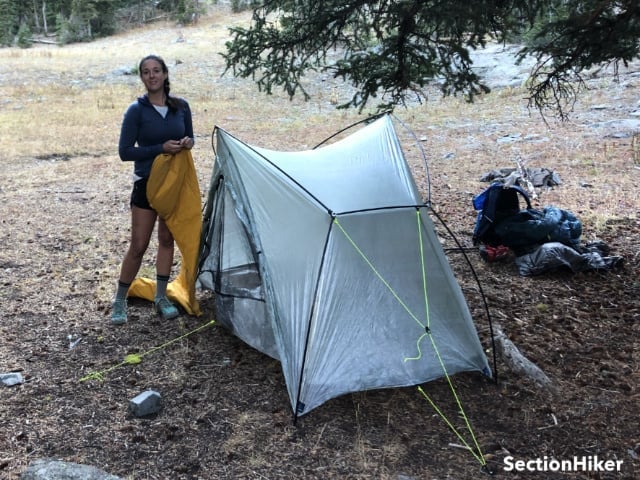
Two Doors / Vestibules
I only like using a two-person tent with dual doors and vestibules. This helps prevent crawling all over the other person for midnight bathroom breaks and gives each person a place to stash their gear in the vestibule. On the Free Duo tent, the rainbow doors open from the top down not along the sides, as is common in many other tents. This makes getting in and out much easier.

Dyneema Composite Fabric (DCF) Body
Dyneema Composite Fabric is the darling of the ultralight backpacking community, and this tent body is built with a lightweight-yet-durable DCF. While it increases the price of this tent, it doesn’t sag when it gets wet, it’s much more waterproof than tents made with siliconized or PU coated nylon or polyester, and it is exceptionally strong and lightweight. If there’s a downside to DCF, it’s that it’s translucent and can make the tent interior warm in hot sunshine. But you can also choose different colors with a slightly heavier material that makes the tent more opaque and provides better privacy.
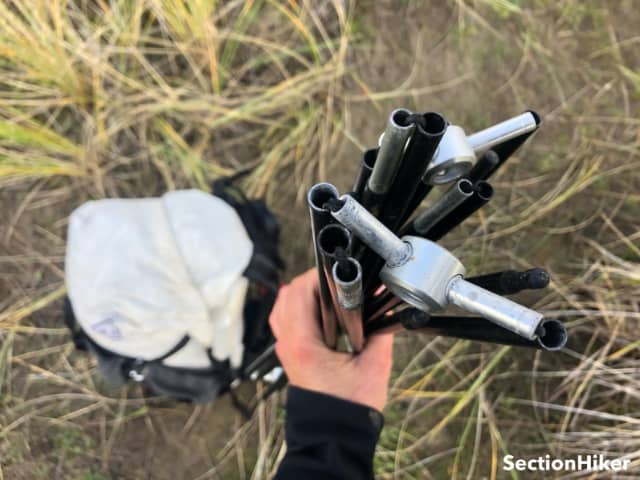
Carbon Fiber Poles
I’ll admit, I was a bit confused by the Free Duo poles at first. My other freestanding tents have single-hubbed poles with a similar layout, thus this one took a few tries to figure out. The poles are two separate H-shaped units, and you need to connect the corners of the tent first, then the peak. From there, you can stretch the remaining connectors to the midsection of the tent. I would avoid connecting the midsection before the peak and the corners since it seemed to strain the non-stretch DCF more than doing it the other way.
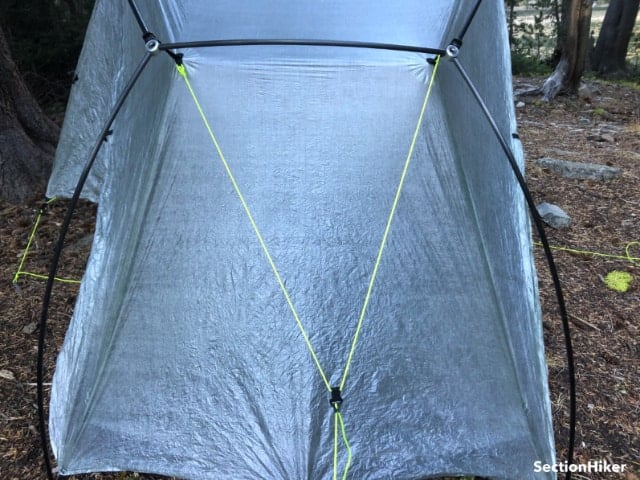
The poles are made from strong, lightweight carbon fiber and are 20 inches long when collapsed. The poles fit nicely into the outside pocket of my primary packs—the Hyperlite Mountain Gear 3400 Southwest, and the Gossamer Gear G4-20. They extend a bit over the top of the packs, but it hasn’t hindered my hiking, even in bushwhacks. The poles are a bit bulkier than my Big Agnes Tiger Wall pole system but weigh almost the same.
Bathtub Floor
More protection comes from the six-inch bathtub floor, which is made with a durable 1 ounce/square yard DCF. This helps protect from punctures and abrasion on rough surfaces without adding too much weight. The six inches keeps splashing rain and mud from getting into the tent and onto your gear. It’s worked well for me, but it can “cave in” a bit if you don’t brace it out at the corners.

Livability
This tent has a lot going for it—weight, structure, waterproofing. The livable space is where the Free Duo falls short. For two people, this tent is a tight fit. Our sleeping pads are pressed against each other at night, and we were nearly smushed against the tent walls before we perfected the pitch and pulled out the four corners as far as they go. I wouldn’t take this tent out with a hiking partner unless I was very close to the person since you’ll be spooning into each other. The sit-up room is great with the peaks and the wide walls, but it feels cramped on the floor.
There is no room for two people’s gear inside the tent, which means your backpacks have to be stored in the vestibules. The vestibules guy out about six inches off the ground, cut high in a standard fashion similar to the Duplex to help with venting. While this is great for ventilation, it means that blowing rain or snow can get underneath the vestibule.
For this reason alone, I’d be hesitant to take this out with a partner where we would need to protect our gear. I’ve used this tent solo in bad weather and with a partner in good weather, and the gear protection with two people would be lacking. In bad weather, I stashed my gear inside the tent with me, but with two people, we had to leave everything out under the vestibules. The vestibules are not super large either, extending just 15 inches out from the tent body. This is a compromise with an ultralight shelter, but pairs of hikers who like space to sprawl inside the tent and need a lot of gear protection might find this tent to be on the small side.

Weather Resistance
As a single-wall tent, the Free Duo has the obvious shortcoming of condensation buildup, but the extreme waterproofing you get from the DCF puts the Free Duo head and shoulders above other single-wall shelters made from more conventional fabrics. The sewn seams are taped as well, and I haven’t experienced any water coming in from the floors or sides.
If you can, I recommend leaving one of the vestibules open for maximum ventilation, as the dreaded condensation from single-wall tents has made many sleeping bags miserably soggy from tent walls. I’ve used this tent in the woods under trees, in open grassy areas, and on the beach. Weather permitting, I leave the vestibules rolled up for more ventilation, as the condensation buildup from rain and environment makes me nervous for my down-insulated clothing and gear

Tent Setup and Stability
This tent comes together in a jiffy. The two H-shaped pole hubs are identical, so it’s hard to screw up the pitch. I lay the tent out on the ground, snap the poles together with their elastic shock cords, then lay the horizontal bar of the “H” across one side of the tent. Repeat on the other side, then pull the corners away from each other and the tent will stand up on its own.
Carefully secure the large plastic hooks located on the top of the tent into the longer sides of the poles (it’ll feel tight with the DCF, so be gentle) and repeat on the other side. If you want, you can then stake out the sidewalls and the vestibules.
We’ve used this tent in snow, rain, and pitched on a variety of terrain, some better than others. It is incredibly tight and stable. Dyneema Composite Fabric has hardly any stretch, which means that once the body of the tent is connected to the poles, it doesn’t sag. This tent sheds snow better than other freestanding tents I’ve used and stays tighter than what I’ve experienced with trekking pole shelters in rain and snow. The tent is built with extended peaks over the doors, which shed water and helps prevent rainfall from collecting on the roof of the tent. Once you get the hang of the dual poles, it sets up really quickly.
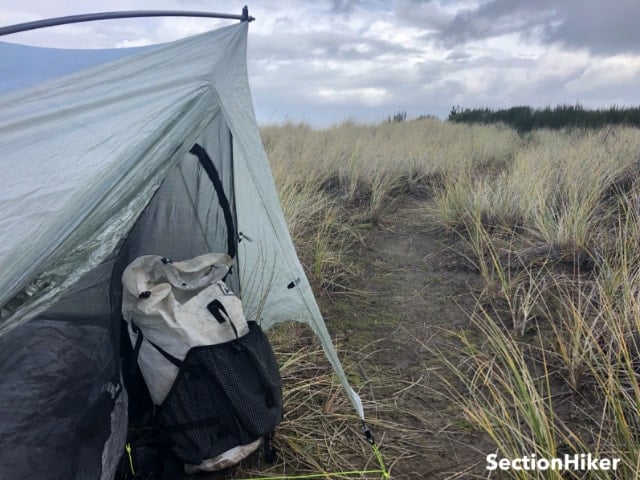
The u-shaped hooks for the vestibule guylines are finicky, and my frozen fingers have fumbled trying to get the guylines in place and anchored. It’s not super easy to get a tight pitch with the vestibules. I usually just give up and deal with the slightly saggy vestibules. Maybe I just need more practice or patience.
Regarding protection, the vestibules don’t zip or Velcro all the way shut—they hook together to close the gaps. This offers supposedly more ventilation, but less protection from blowing rain. The tent body is tight and waterproof, but with the shorter-coverage vestibules that don’t secure all the way, this isn’t the most fully protected tent on the market. Pitched with tight vestibules and guyed out, you’ll have better luck, but it will take more patience to get right.

Durability
I haven’t experienced anything negative about the durability of the Free Duo, but as with any ultralight piece of gear, you have to treat this tent well. Depending on where you pitch, consider a piece of Tyvek or a groundsheet to protect the floor. The tent is also very tight as it connects to the poles, and I’ve been careful to set it up with the top connectors last to avoid stretching the DCF too much. The fact that the DCF doesn’t stretch means it stays taught in rain and doesn’t sag, but it also makes it more susceptible to tearing since there’s no give.
The guy-outs have reinforcements so you can stake them tightly without worrying about tearing the DCF, which is some added peace of mind. Zpacks lists a lifetime of at least a 2,500-mile thru-hike on their website, which means they’ve put thought and care into advertising this tent towards long-distance hikers. They also advertise easy field repairs on the tent body and floor, but since I haven’t used this tent for over 2,000 miles, I can’t speak to that.
I am also very careful when zipping up the doors. Since the tent body is made from a no-stretch DCF, the doors can feel tight to zip, and I’m wary of stretching them too much and tearing the mesh. This hasn’t happened, but it’s on my mind when I finagle the zippers into place to fully zip the tent.

Overall Usage
The Zpacks Free Duo is a solid shelter with a lot going for it, and a few detractions. It fits a category gap in the market: a freestanding tent with comparable weight to a tarp tent. It’s convenient and stable and can endure inclement weather. I love that I can pop the poles into the corners, hook the top to the poles, and have a completely stable standing structure in just a few minutes. When the tent is wet from the night before, the DCF makes it easy to dry off the inside with a rag or bandana.
I don’t know if I would recommend this tent for two people who like plenty of space. My partner and I use standard-sized sleeping pads, and they are pressed right up into each other unless you work extra hard to stabilize the four corners, and the Free Duo only reaches its maximum space when you pull the pole hubs out as far as possible, which can be finicky to achieve.
When I used this tent on my own and wasn’t able to stake the sidewalls, I pushed heavy items from my pack (food bag, electronics bag) into the four corners to get as much space as possible. The tent will certainly stand up on its own, but the bathtub floor can feel like it’s caving in unless you have something to anchor the corners.
I prefer tents structured with a wider floor than ceiling, which means this interior can feel cramped to me. I’m perfectly happy taking this tent out with my partner on shorter trips, but for anything longer where we want more space, I opt for my other two-person tent.
Additionally, this tent is translucent in daylight. If this is an issue for you, consider that it’s only entirely private in low light or at night. Zpacks does offer the option of a heavier DCF construction, which adds some price and weight to the model.

Recommendation
The Zpacks Free Duo is designed for hikers who care about weight savings but don’t like the hassle of a trekking pole shelter, or might need to pitch on rock or sand. It’s a reasonable weight for solo hikers, and very stable and waterproof. The price is jarring, but you’re getting the top-end of materials in the DCF construction, and a smart design that can be pitched anywhere.
I’ve pitched it on sand, rocks, and some miserable campsites and had no trouble at all with the stability. It’s very versatile and doesn’t have a super large footprint, meaning you can get it wedged into some pretty tight spots. It’s fast to set up, and if you’re careful with the ultralight materials, it should last a long time. The single-piece construction is simple, and leaving the vestibules rolled up (weather permitting) helps mitigate condensation issues. Livable space feels small for two people, but the freestanding convenience, waterproofing, and low weight make it a strong contender for my go-to shelter this season.
Disclosure: Zpacks provided the author with a sample tent.
SectionHiker is reader-supported. We only make money if you purchase a product through our affiliate links. Help us continue to test and write unsponsored and independent gear reviews, beginner FAQs, and free hiking guides. SectionHiker.com Backpacking Gear Reviews and FAQs
SectionHiker.com Backpacking Gear Reviews and FAQs 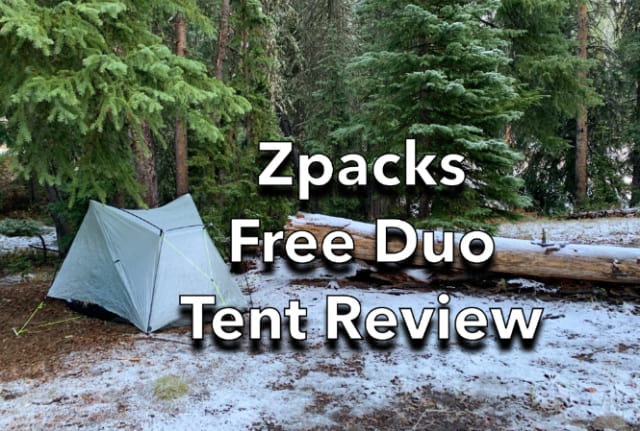
Another two person tent with room for one. And as a one, its heavier than a one person, such as the TarpTent Notch Li. The Notch also has two vestibules and they are a good size. One for storage and one for cooking, hanging out. If the Notch Li came with a “Front Porch” accessory to one of the vestibules like the Rainbow does, it would be even more amazing. Thanks for the review. For my money and weight, I’d rather carry the Notch alone, or put my second Notch in my partner’s pack and let us camp near, but not on each other.
I think this tent is designed for people who really can’t stand the thought of a trekking pole tent…which equates to anyone who has a Big Agnes Semi-Freestanding tent, which this is technically since it has to be staked out to stretch the corners, stake out the vestibules, and prevent the thing from being blown away like a tumbleweed. The Notch is a trekking pole tent and a non-starter for the majority of people. Zpacks is trying to reach an expanded user base, not sell this into the thru-hiking crowd.
I’d have to disagree in my use case. I’d love a trekking pole tent that rivals my Tiger Wall 2. The problem is, for the price, weight and features I can’t find it. I got my TW ul2 on sale for $350 which is SIGNIFICANTLY less than what this thing is going for. Unless I’m missing something and there’s a trekking pole tent with the same features and a similar prices as the TG ul2?
The notch has a pole set if you want it It must be staked out, yes, but this tent really has to be staked to be fully functional. Even full domes like Hilleberg need stakes to be fully functional. It’s not a bad tent at all. Just too small for me as are most two person. I just consider the Notch design the ultimate function and comfort even if it means carrying one for each person. Thanks for doing all these reviews
You can’t make a dome with trekking poles, so you’re unlikely to find anything comparable from the trekking pole tent world.
Now THIS Z-Packs tent is innovative – finally.
Great Article! Love your website. I currently own a Duplex, and my tent keeps getting knocked down when we have over 30 MPH+ winds in the Sierras and along the PCT. I am in the market a 4 season tent, how would you compare this to Nemo Kunai? I called Nemo and the Kunai is on Backorder until Feb / March time frame and want something now for the winter season.
That’s really kind of an apples and oranges comparison. The Free Duo is not really a winter tent and I wouldn’t recommend using it for such. I can’t say that I’d really be that interested in using it under any circumstances to be honest. The Kunai is basically a mountaineering tent with a single front door, which has its pros and cons. I’ve been using a BD Firstlight in winter for many years which is also single wall and truly freestanding, but can withstand those winds if anchored properly. The two other tents I’d recommend looking at are the Big Sky Chinook which is available in a 1.5 size and a 2 person size or the Slingfin CrossBow. Here are our top 10 picks for 4 season tents. You’ll see those listed as well as others. The BD Firstlight is probably one of the few winter tents that is widely available for immediate purchase.
https://sectionhiker.com/sectionhiker-gear-guide/10-best-four-season-tents/
Thank you for the great review. I have used my Duplex for quite a while and really like it. The last time out, I had a challenge finding a campsite with a large enough footprint for it. I finally got it set up, only to discover I had put it directly over a treeroot making it impossible to lay down. I couldn’t just “move it” because it wasn’t freestanding. I had to start over. I have yearned for all the greatness of my Duplex with freestandingness of my old Big Agnes tents. I am buying the Free Duo! I expect it will displace my Duplex as my most favorite tent.
I’ve been using the Duplex (occasionally with the flex pole option) for 3 years as a solo and occasionally 2 person tent when the wife comes along. # JMT’s w the duplex (didn’t bring the flex poles due to weight trimming). But hassling with the 8 stakes every day is a pain – I like the idea of the Free Duo only requiring 2 stakes in calm weather. Too bad Zpacks discontinued the camo color! Thanks for reviewing the Free Duo.
I did it… I bought the DUO! I didn’t want to give up the things I enjoy about my Duplex, but there are times I want a freestanding tent. So far, the DUO is great. I use it solo with my Siberian husky. There’s less floor space than in the Duplex, but more head room. I prefer that dynamic as sometimes it was challenging to find a spot large enough for the Duplex. It’s creates a lot of usable space, and no damn trekking pole in the middle of the doorway!! Yeah, it would be nice if the poles were shorter, but it would add weight to add all those heavy connectors. The DUO is super simple and fast to pitch. Also, stakes are optional which is ultracool! So far, I love it. I’m a bit worried about how much tension is on the pull outs that snap onto the cross poles. I put some tiny Z-line cordage on the snaps so I have the option of setting up with less tension in nice weather. Thanks for the review, it convinced me it was worth it to buy the DUO and I’m very happy I did.